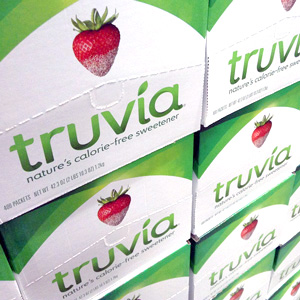 Truvia is a granulated sugar substitute.
Truvia is a granulated sugar substitute.
I have tried many sweetener brands, but finally settled on Truvia as my preferred option. I now use it in all of my low-carb recipes.
Lately, I’ve been getting lots of questions and comments about Truvia.
There seems to be some confusion on whether it is suitable for low-carb dieters.
Why some of us are confused about Truvia
Truvia have several products in their range. Some are great for low-carb dieters, but some aren’t.
All Truvia products are sold under the same brand name, and have similar looking packaging. So it is potentially confusing for us.
Double check product names and nutritional information on the labels before buying.
Here’s what you need to look out for.
YES – Truvia Calorie-Free Sweetener
Zero net carbs, PERFECT for low-carb diets
Truvia Calorie-Free Sweetener is made from Stevia leaf extract and erythritol.
This product comes in sachets, in a spoonable plastic pack, and in a pouch.
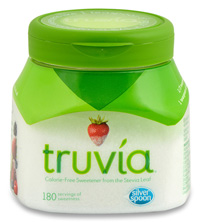
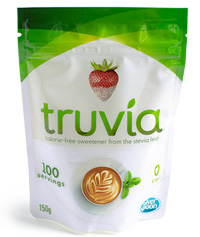
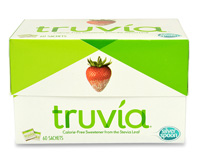
It doesn’t contain any digestible carbs, and its net carb count is zero. So we can safely use it as part of a low-carb diet.
The nutritional label does show some carbs, due to FDA regulations. However, these all come from erythritol and are not digestible (otherwise it wouldn’t be marked up as zero-calorie).
The exact product name varies in different markets – I have seen it called “Calorie-Free Sweetener”, “Natural Zero Calorie Sweetener”, “Nature’s Calorie-Free Sweetener” etc.
The keyword to look for is “calorie-free”. There is also a “zero calories” stamp on the packaging.
NO – Truvia Nectar, Truvia Brown Sugar Blend, Truvia Baking Blend
Contain sugar, NOT SUITABLE for low-carb diets
Truvia range also includes products that contain Stevia blended with sugar – Truvia Brown Sugar Blend and Truvia Baking Blend, and with honey – Truvia Nectar.
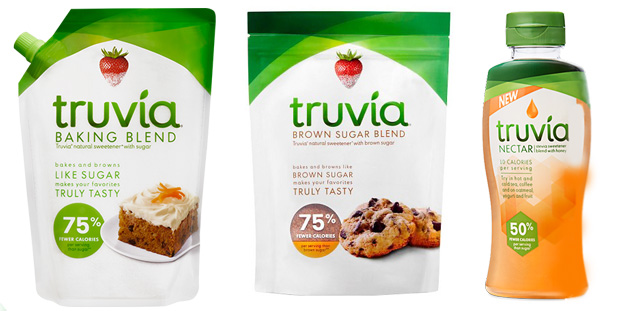
The sugar content is clearly marked up on the packaging. These products aim to help people on standard diets lower their calorie consumption.
Note the stamp on the front of the packages says “75% fewer calories” – not “0 calories”.
These are great for people who would otherwise just eat pure white sugar. But not suitable for low-carb dieters.
Reasons to use Truvia Calorie-Free Sweetener
There are many sugar substitutes on the market. Let me explain why I settled on Truvia as my product of choice.
Bulked with erythritol – no cheap and nasty fillers
Stevia extract is extremely sweet – about 200 times sweeter than sugar.
Measuring out 1/200 of a teaspoon is not exactly practical. Stevia extract is usually blended with bulking ingredients for granulated sweeteners, or alcohol for Stevia drops.
Some products are bulked with cheap and nasty fillers, such as maltodextrin or dextrose. These substances are not sugar-free, and can actually negate the benefits of using Stevia.
Truvia includes erythritol as the bulking agent. Erythritol is a naturally derived sugar alcohol (polyol), which contains no digestible carbs. Its texture and weight are similar to sugar. It doesn’t have a strong laxative effect like some other cheaper polyols. So it is the perfect option.
Truvia Calorie-Free Sweetener contains no other ingredients except Stevia, erythritol and flavourings.
Ingredients do not affect your blood sugar
Do “zero calorie” and “zero carbs” claims seem too good to be true? I was sceptical at first too.
But Truvia Sweetener has been tested in clinical studies of people who have type 2 diabetes. The results show that consuming Truvia does not affect blood glucose or insulin.
I have used Truvia on many occasions without interrupting my ketosis.
One word of caution – our bodies are complex systems, and everyone is different. Sometimes simply consuming sweet-tasting foods (even without any actual carbs) can disrupt your low-carb diet progress.
The effect of sugar alcohols like erythritol also vary by individual, although most people don’t have any adverse affects.
If you are just starting out on a low-carb diet – or if it’s hard for you to get into and stay in ketosis – then be careful with Truvia or any other sugar substitutes. Perhaps try a small amount first and see how it affects you.
Right texture, smell and taste
The texture of Truvia is very similar to sugar, although the taste is sweeter.
The flavourings blend in Truvia is excellent. Unlike some other sweeteners, it doesn’t smell or taste artificial or laden with chemicals.
There is no unpleasant aftertaste – another common problem they somehow managed to eliminate.
Multi-purpose sweetener
Truvia works equally well in baking, desserts and beverages.
So it is a multi-purpose sweetener, unlike some other products.
For example, Stevia liquid drops are great for sweetening your tea and coffee, but you can’t bake with them.
The only time it didn’t work so well for me was in low-carb chocolate-making.
I tried to sweeten 100% cacao solids chocolate, melted over Bain-Marie. I guess the temperature wasn’t hot enough, so Truvia granules didn’t quite melt into the chocolate. I worked around this by powdering Truvia in a coffee grinder first – it worked ok after that.
Produced by a large company
Truvia brand is owned by Cargill Foods – a huge international food company. This gives Truvia two advantages compared to smaller brands.
First, it is quite easy to buy.
In the UK, Truvia is available from Tesco, Asda, Coop, Morrisons, Sainsbury and Waitrose.
In USA, Truvia is available from Whole Foods Market, Walmart, Costco and Sam’s Club.
Secondly, thanks to its bigger production scale, Truvia is reasonably priced. Inevitably, it is a lot more expensive than white sugar. But cheaper than other sweeteners produced by smaller niche companies. And much cheaper than natural Stevia leaf powder (Although obviously not quite as natural).
Controversy – “Natural” claims
One word of caution regarding the usage of the word “Natural” to describe Truvia. The company does use this word extensively in their marketing and on Truvia packaging.
It is true that all of Truvia ingredients were real foods at some point in the beginning of production cycle. So it is more natural than artificially synthesised sweeteners, like aspartame and sucralose.
However, both Stevia leaf and erythritol are processed very heavily before they become Truvia.
So I would personally not use the word “natural” to describe this product. If you are on Paleo or just trying to eat clean, this is not the right sweetener for you.
I have reconciled myself with the fact that some ingredients do require a degree of processing. Pretty much all sweeteners (and real sugar) are processed.
You can find all-natural, unprocessed dried Stevia leaves, but that’s very niche, and more expensive. And you couldn’t bake with it. Same goes for Luo Han (monk fruit) extract, which is very hard to find.
All other natural sweeteners tend to be high in carbs – honey, agave nectar etc. Great if you are on Paleo but definitely not low-carb.
I made my peace with the fact that Truvia is not quite as natural as Cargill would like you to believe. It has plenty of other advantages. I will continue to use it in my low-carb recipes.
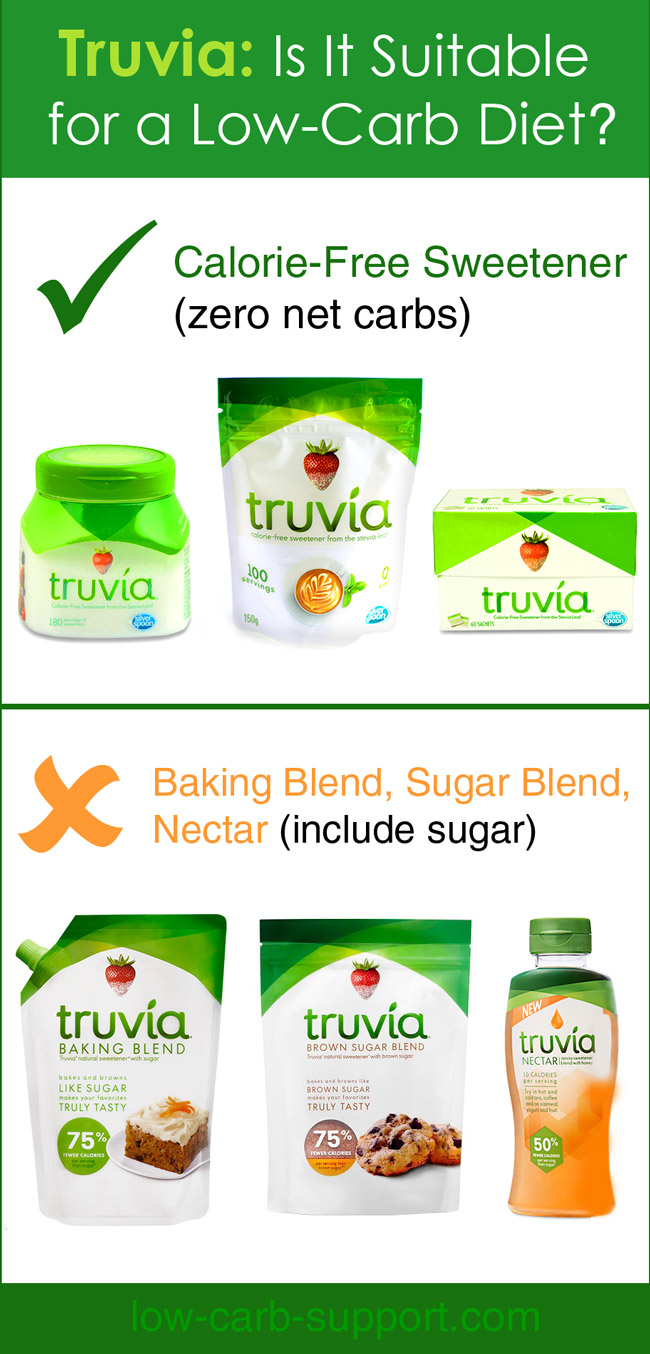
I am not understanding why you’re mixing the erythritol and stevia powder
when you’re using a recipe
Pingback: Is Truvia Keto – KETOAXIS
How much actual cane sugar is in a half cup of Truvia cane sugar blend?
Thank you.
can I still get in on this conversation? I just read my truvia label- the packet – before I put it into my coffee, I had someone double check it for me because I was surprised…. it said THREE GRAMS OF CARBOHYDRATES. how is that possible when everything everyone says and what I read on line says ZERO? please help, getting so confused and had it down to Truvia and Stevia in the Raw till I saw that label today. ALso, less than 1g carb can mean .999 gram carb so even having two cups of coffee per day w three stevia in the raw means 6 grams. Ugh. so confusing.
Hi Lisa
Yes, you are absolutely right – it is really confusing.
Here’s the thing about Truvia. Although technically it is all carbohydrates (99g out of 100g) – all of these carbs are NON-DIGESTIBLE. The main ingredient is erythritol – the only polyol that’s genuinely zero-carb.
If you look at the calories count, it is stated as zero. The reason they are allowed to label Truvia as zero-calorie is because it has no digestible carbs.
So you are definitely safe!
I have always been confused about how Stevia can have carbs but no calories. Thanks for your explanation.
Thank you April, best of luck with your diet!
I so appreciate these comments as I’m still learning about the whole low-carb diet & sweeteners’ impact on blood sugar. Got a feeling I’ll still be learning 30 years from now. I was ready to ask about how to bake w/Stevia, but I think John gave great, practical advice. Thank you so much John & Carbophobic.
Thank you TeeJay, best of luck with your diet!
Is the baking blend of trivia ok for low carb diets
Hi Dena, as mentioned in the post, Truvia Baking Blend is not ok for low carb diets. It has quite a lot of actual standard sugar in it.
I am not understanding why you are mixing the erythritol and the stevia powder
when using a recipe
thank you
Yes, this version of Truvia is okay on a LCHF/Atkins/ketogenic diet, much better than the maltodextrin laden artificial sweetener known as Splenda.
But there are cheaper options out there. I usually get a 5 pound bag of erythritol off of amazon (about $5.80 per pound), and a 4 oz container of powdered stevia for under $20. Then when using in a recipe, use the erythritol 1:1 for a sugar replacement, but just add about 1/2 tsp of stevia per cup of erythritol to boost its sweetness to that equal of sugar. The stevia seems to mostly rid the erythritol of most of its cooling effect, and the erythritol helps keep any bitter/metallic aftertaste from the stevia at bay. So the two sweeteners tend to complement each other very well.
The thing about the so called zero carb Splenda, is that IS NOT zero carb. According to their own label, it would be around 24 carbs per cup of a VERY HIGH glycemic index ingredient (around 105GI) known as maltodextrin. I’ve also heard of many people eventually having an allergic reaction (rashes) to it (Sucralose) after a few years of using it. I haven’t heard of any artificial sweetener yet, that doesn’t have some bad health side effects, and Splenda/sucralose is no different.
However, I think they might even be lying about even that number, as when I tried to look up the carbs in just maltodextrin, fatsecret.com said it had about 186.6 carbs per cup ( https://www.fatsecret.com/calories-nutrition/generic/maltodextrin?portionid=5552573&portionamount=1.000 ). That’s nearly as much as actual sugar, but at twice the GI. This is why it is used in many weight lifting supplements used to “carb-load” after a workout, as it actually absorbs much faster than most sugars, including glucose. I don’t know, maybe it has to do with how finely ground/course it is. But at any rate, the fact that its GI is twice that of sugar will probably make it “act like” twice the amount of carbs that are there (more like 48 carbs per cup), which makes it verboten on my diet….
Hi John, many thanks for the tip about mixing erythritol and Stevia yourself. Seems like a good idea and yes, I agree that it’s always safer to mix the ingredients yourself, rather than trust sweetener manufacturers to fulfil their promises.
Completely agree with you regarding maltodextrin and other fillers – they are full of carbs and negate any advantage of using sucralose or another sugar substitute. I think looking at the calories data is a good indicator – if there are calories indicated on a sweetener packaging, they can only come from carbs.